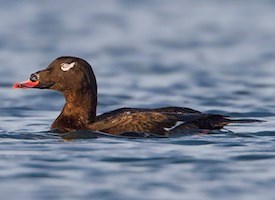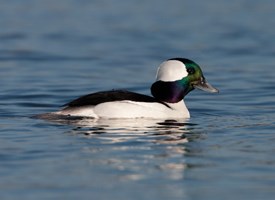
Today marks the start of National Audubon Society‘s 115th Christmas Bird Count (CBC)! From December 14 through January 5, thousands of volunteers across North America are invited to go out, count birds and contribute data to an early-winter bird census.
When looking at the CBC Map, you will see that every state offers a significant number of local counts, which cover about a 10-15 mile diameter circle each. Since every CBC is a real census, and since the 15-mile diameter circle contains a lot of area to be covered, single-observer counts are not allowed. To participate on the CBC, you need to join an existing CBC circle. You can find one near you online!
All data from the local counts across North America gets compiled, reviewed and documented. The Christmas Bird Count allows researchers, conservation biologists, and interested individuals to study the long-term health and status of bird populations across North America.
For example, in the 1980’s, CBC data was used to document the decline of wintering populations of the American Black Duck. Conservation measures were put into effect shortly after, to reduce hunting pressure on the species.
Learn more about how the CBC data has been used recently in Audubon’s Birds & Climate Change and Common Birds in Decline reports.
I joined the local Sandy Hook Count this morning, which covers a 10-mile radius around Gateway National Recreation Area – Sandy Hook Unit in Highlands, New Jersey.

The Sandy Hook Count is split up into smaller territories, since there is such a large amount of bird habitat to cover in the park. I joined members of Monmouth County Audubon Society and helped count birds in the South Sandy Hook territory. We scanned Sandy Hook Bay for waterfowl and gulls, walked to Nike Pond and looked for songbirds, and we also traveled through the ancient Holly Forest, where we saw a few raptors. Many areas of Sandy Hook that are usually closed to the public were open to us for the CBC.
In the short three hours that I joined the group, we watched a number of Harbor Seals sunning on Skeleton Hill Island (!) and saw and heard a number of great birds:
- American Black Duck
- American Crow
- American Goldfinch
- Black-capped Chickadee
- Brant
- Bufflehead
- Canada Goose
- Carolina Wren
- Dark-eyed Junco
- Double-crested Cormorant
- Gray Catbird
- Great Black-backed Gull
- Hermit Thrush
- Herring Gull
- Horned Grebe
- House Finch
- Northern Cardinal
- Northern Harrier
- Northern Mockingbird
- Peregrine Falcon
- Red-breasted Merganser
- Red-shouldered Hawk
- Ring-billed Gull
- Sanderling
- Sharp-shinned Hawk
- Song Sparrow
- Swamp Sparrow
- White-throated Sparrow
- White-winged Scoter

Wondering how this incredible citizen science initiative all got started? The first Christmas Bird Count (CBC) was completed on Christmas Day of the year 1900 as an “alternative activity to an event called the ‘side hunt‘ where people chose sides, then went out and shot as many birds as they could.” The group that came in with the largest number of dead birds was declared the winner of the event. Frank Chapman, a famous ornithologist, recognized that over-hunting would only exacerbate declining bird populations, and proposed to count birds on Christmas Day rather than shoot them.
To get involved in this historic event, visit The National Audubon Society’s website.
